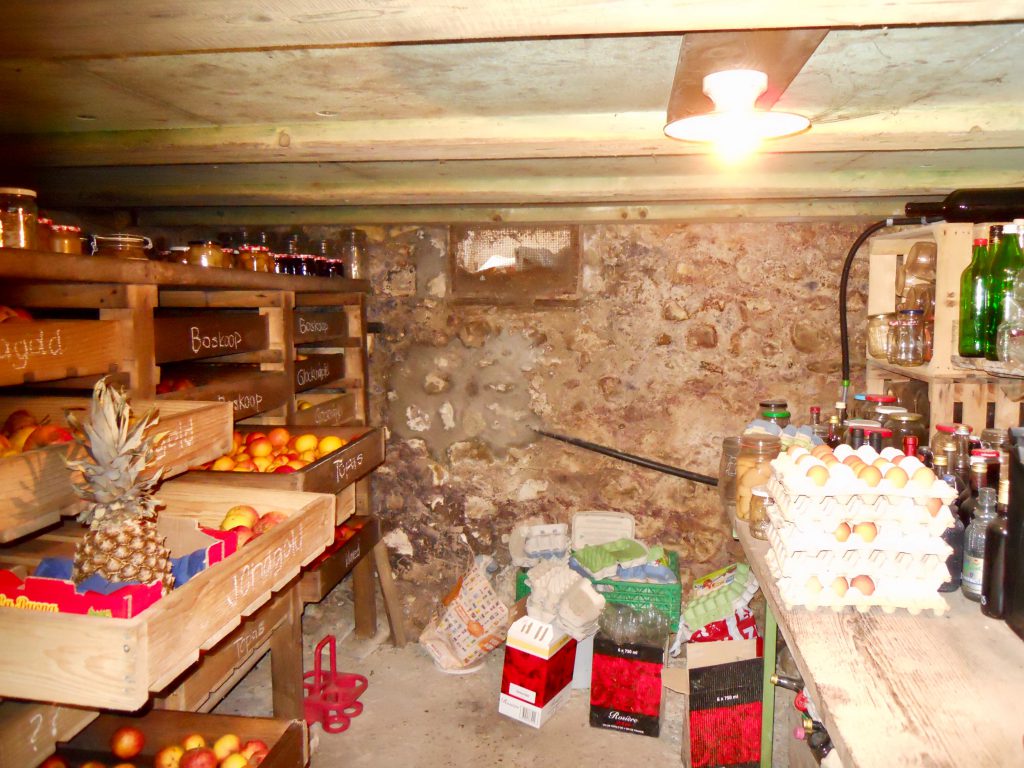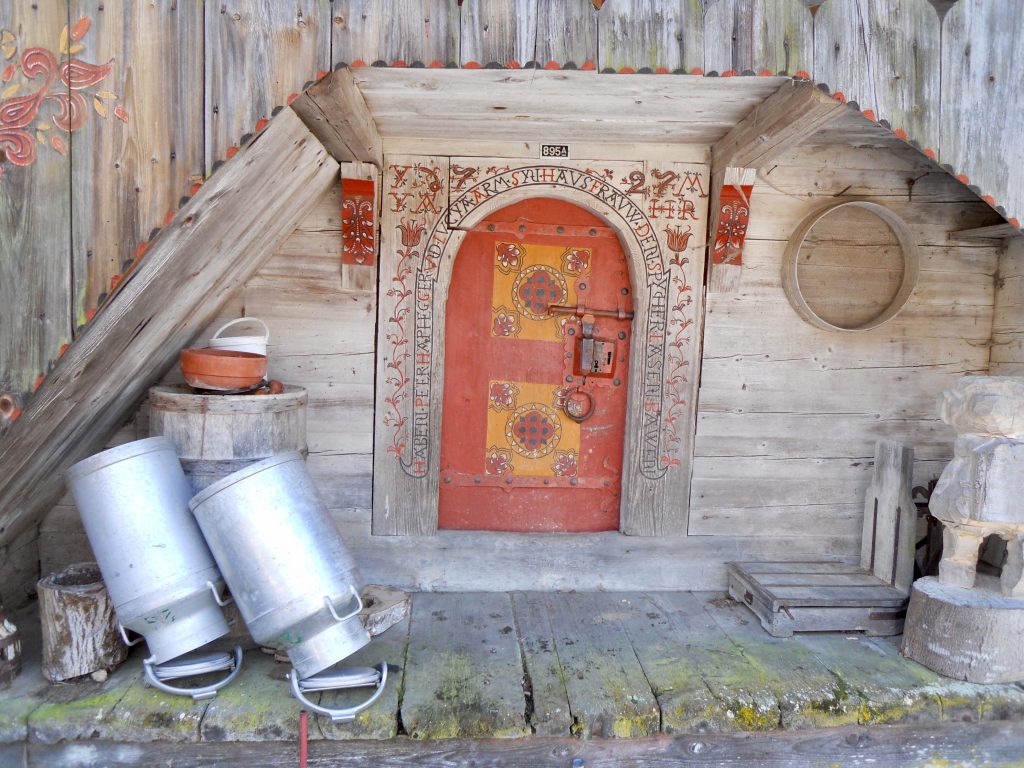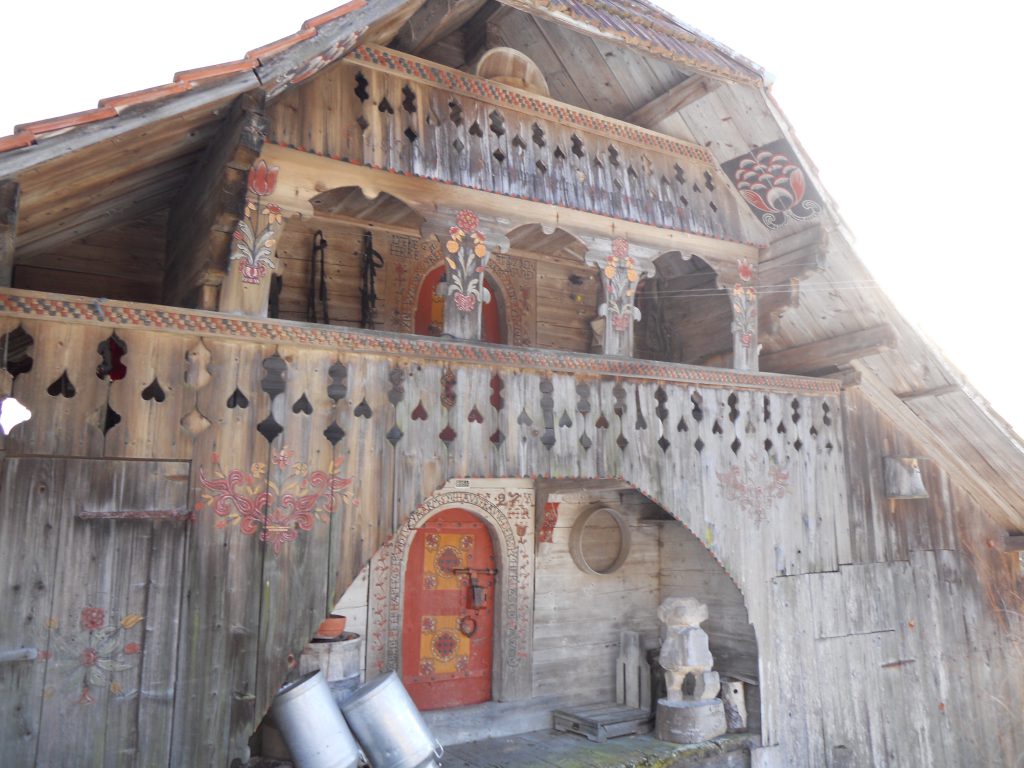When I planned my trip to Switzerland, I was hoping to visit places important to Anabaptist history. In that, I have been quite successful — I’ve visited the Trachsalwald Castle, and the famous “Täuferversteck” (Anabaptist Hideout) in a barn above the town of Trub, known as the Fankhauser barn. I have also visited the first existing Mennonite church, which is in Langnau and therefore the oldest one in not just Switzerland, but also in the world. The Koch Family are members of this church. I will be writing about these experiences in other posts.
Never in a million years would I have dreamed that the farm I would be visiting would turn out to be an Anabaptist hideout. But that is exactly what I found out one day when I went with Hadassah to the basement of the main farmhouse to bring up some apples from the root cellar for a snack. Elizabeth, the woman of the house, showed Hadassah and me how to open the doors and turn on the lights to get the apples. As she did so, she told me this story that I clarified with the help of Miriam and Marco’s excellent translation skills:
Elizabeth and Martin hired a carpenter to come and put in a new stairway to their basement/root cellar, because they had a spiral staircase and they were feeling the cold from the basement. So they decided to put in a wall and build a cement stairs to the root cellar. The carpenter told them that he has observed from the houses in the Emmental Valley that the homes with direct access to their basements were Anabaptist-owned farms.

Later, they found out from Hanspeter Jecker, a renowned Anabaptist researcher here in the Canton Bern, that in the winter of 1733 and 1734, Peter Habegger, the owner of this farm, himself an Anabaptist, was hiding an elder of the Anabaptist church, whose name was Hans Martin. It is also believed that the house was used as an Anabaptist meeting place.
What I know about Hans Martin comes from Hanspeter Jecker’s research. Hans Martin was from a place called Pratteln in the area of Basel. He was taken captive for his Anabaptist beliefs by the authorities in Basel when he was thirty years old. But then the parish priest was convinced that it would be better to free him with the condition that he “better himself” (recant his religious beliefs) within two months.
Two months later, on July 19, 1719, when Hans Martin was unwilling to renounce his conviction, Hans Martin was expelled permanently. Thus began a period when he and his family were on the run from the authorities. They wandered from one town to another: Grenzach near Basel, Groningen in Friesland in 1720, where they met with other Anabaptists from the Canton Bern, back to Pratteln, the area of Biel, and then near Corgemont in a place called Sonnenberg.
Hans Martin’s wife died in 1730. At the end of the same year, it is known that he met with a Pietist leader in Neuenburg named Hieronymous Annoni.
In the winter of 1733 and 1734, Hans Martin appeared in a remote part of the Emmantal Valley, on the farm Hockboden. That is THIS farm where Miriam and Marco live, and where I am visiting. At the time, the root cellar was a hole in the ground. Apparently that is where he was hiding.
Hans Martin eventually emigrated to the United States in 1736, where he sought a home in Pennsylvania to settle down on.
Elizabeth showed us the building on this farm where they stored the grain, which was called a “Spycher” and what we would call a granary in English. At the time, it was common for people to make decorative doors on such buildings. Here is a photo of this building.

It says that this granary was built in 1727, for Hans Hapegger and Lucy Aarm, his wife. This building looks to me like something that belongs in the story of Heidi.
So here is another chapter about my visit to the Little House on the Farm called Hockboden in the Emmental Valley. I feel like I am living a dream, which makes me feel just so fortunate.



What an adventure you are having, Saloma! Thanks for telling us about it- and keep it up!
Interestingly,a ‘spycher’ is what in PA Dutch we called the upstairs of a house. A lot of words and meanings get changed, no doubt about it.
For instance, the German couple I was tutoring told me that ‘hock anna’ would be considered rude- it is what one would tell an animal, kind of like the difference between ‘fressen’ and ‘essen’. When inviting a person to sit, one should say ‘setzen sie’ preferably with ‘bitte’ attached. :)
I thought the same thing about a ‘spycher’that Elva mentioned.
In my community, we wouldn’t pronounce the “ch” so it was more like “speyer.” Language is so interesting.
Elva, I agree, there is such a connection between language and thought. I am always amazed at the difference in the way German-speaking people express certain things, as compared to English-speaking people. The other day, Hadassah was so excited to tell me that “Ein Baby Kuh ist auf die Welt gekommen.” Literally translated, this means baby cow has come to this world. I was really surprised to find that there is no difference between the way one says a calf is born or a baby is born, like essen and fressen. So in German the emphasis is on the spirit come to earth, and in English we say a baby is born, so the emphasis is on the birthing process. Fascinating.
I did know that Germans will say, “Sitzen Sie sich, bitte,” I did not know that they think “hock anna” is rude, only used for anaimals.
Thanks for your comments, Elva. It is always good to hear from you.
Salome, I am so happy for you that you can visit the Emmenthal. It is one of my most favorite places to be. My Swartzendruber ancestors came from Trub. In fact it is very close to the Taufersteck. My husband and I have been to the area several times and each time I feel like I am coming home. I love the area and I hope I can go back more times. I have Yoders, Millers and Hochstetters also in my forefathers and have been able to visit most of the places where they came from in Switzerland. It is a special gift to be able to go there.
Thanks so much for sharing your story of your visit and can hardly wait to see what will be coming.
Enjoy your stay!!!!!
greetings from Mary M.
SO very happy for you, that you can travel around the area there! So THANKFUL that you are sharing with all of us! This is a great way for me to travel, just following your reports & pics.
Safe travels and Blessings to you ~
Thank you, Carol, for your interest. I’m so glad to have you with me on this journey. :)
Mary, it sounds like you and I are related. My father’s ancestors come from Trub as well, and those same names are in my lineage. We should compare notes sometime when I have my ancestor chart handy. You’re right, it is such a Blessing to be here.
Thank you for your interest. I will be posting more soon.
A family friend recently traced our ancestry back to Trub. Our last name being Swartzentruber but was traced back to a Hans Schwarzentruber of Trub
Hello Tyson,
I believe I’ve heard of Hans Swartzentruber from Trub, but I’m not remembering in which article I read about him. I believe I also have ancestors from Trub in my father’s ancestry. Small world.
Totally fascinating! Can’t wait to hear more!
Kris, thank you for your interest. I’ll be back with more soon.
I am marveling at the fact you are in the Emmental Valley, reporting on your adventures with beautiful photos to take us there, and we’re wherever we all are, being transported to the Emmental Valley by receiving your reports. More or less instantly.
I know, Johanna, technology is a marvel. And here you are, living within minutes from my home. Makes me realize how far I am from home.
Hello Saloma:
I am so excited to hear about your upcoming posts on Trachselwald Castle cause that’s were my Martin ancestor was imprisoned until May 1732…
Here in Canada the old order Mennonites call the grainery the “frucht comma”
Oh golly, you know I will be bugging you for ALL the info on HANS MARTI once you get back to the USA and after you have had some time with David and the family> :
Best Regards;
Delmer B. Martin
Delmar, thank you for your enthusiastic interest. I wonder if your ancestor was related to Hans Martin?
I will be happy to share the information I have on Hans Martin. It is much more detailed than I reported here. The document I have is in high German.
Yes, I miss David, and I look forward to being with him again.
I’ll scan this document and send it to you upon my return home.
Delmer,
I want to ask if you have DNA tested anywhere. The reason I ask is because my ancestor, also Hans Marti, immigrated from nearby Rothenfluh in the same year, 1736 on the Ship Princess Augusta, and I am desperately trying to prove a connection to Hans Martin of Pratteln. My ancestors settled in Lancaster, PA…Cocalico/Ephrata to be exact. Please let me know. Thank you.
Saloma, as I reflect upon this post, I recall the disappointment that you felt when you didn’t receive the scholarship. From this amazing dream that you are now experiencing, it seems like God is blessing your nonscholarship path in ways beyond the comprehension that you had during your loss.
I appreciate so much that you are posting your journey in Switzerland. As I have said, I find your life more interesting than a well written novel. I also wonder where all this research will eventually lead you!
Denise, I have thought of exactly what you are saying. Sometimes it is almost too much for me to soak in. I am just ever so grateful.
It is a pleasure to share this, so you are quite welcome. Thank you for your interest.
Ah yes what a excellent point Denise! When one inherits a “goodly heritage” it is a huge blessing. It is not just a bricks and mortar matter, I imagine trecking thru that neighborhood in SZ as being a Spiritual experience that goes beyond anything normal. It is something that cannot be stolen or taken from you and that moth and rust cannot corrupt. The Modern World is so pitifully “looking to the future” for something good (anything good) that hopefully, maybe, might appear for them to guide them and give them nuggets of knowledge…while those who KNOW their goodly heritage can be at peace and “at home” just knowing the degree of TRUTH (FREEDOM) that has already been established by the Good and God Fearing ones who came before us. Knowing some of the history about the area (and the Anabaptists) where Saloma went in SZ I can well imagine the peace and quiet tranquility that Saloma could experience firsthand NOW knowing what came before us was quite different than what we can experience now. It is a mindboggling dose of TRUTH. We are all connected to the soil/earth and the Heavens whether we think it is true or not…and for those that are blessed enough to know their connections to both, it thoroughly proves that “Home Is Where the HEART IS” and it all comes down to what each human beings ideal of home really is! There is something really really special about “being home”
How humbling it must be to walk were so many Anabaptists before you placed their feet. Who sang their hymns and worshipped their God in their own way knowing all along they could be found out and arrested and often times killed. How brave they were!! How faithful and what strong convictions. I often wonder how we in America would handle such a thing. Would we be able to stand up for our religious beliefs, no matter the cost? How God has blessed you Saloma in making it so you came in contact with this beautiful family and for them to be living on a farm with such history. We, your readers are blessed to have the technology to take this walk with you.
Pamela, yes it is quite something to walk the same paths of my ancestors and I feel very fortunate to have these experiences.
Saloma, I just love the fact that you are there experiencing, learning, discovering! Reading all the comments, I have to agree with all about wanting to know more and fascinated by what you have already been able to share! Thank you so much!
Peggy you are quite welcome, and thank you so much for your interest.
We just returned from a trip that included a visit to Fankhaus and Trub and area. My husband, John’s ancesters came from that area and he wanted to visit. We never expected more than to see the area but found the history of the area included his family. We visited the museum at the Hinter Hutten thanks to our hosts the Baumgardeners. This history had not been known until now. He found the name of Niclaus Fankhauser who was the father to John’s ancestor who migrated to America in 1819. He will be sending our family tree info to Regula Fankhauser.